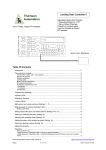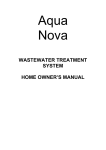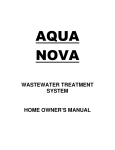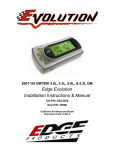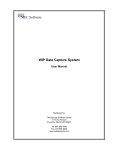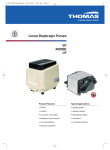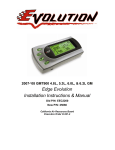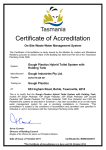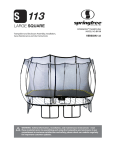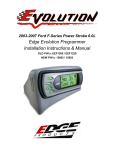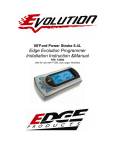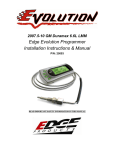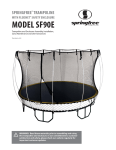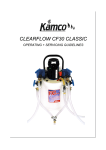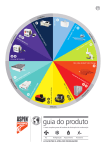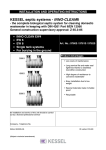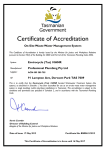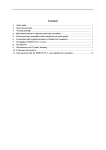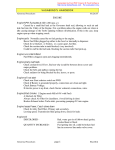Download Certificate of Accreditation
Transcript
Certificate of Accreditation On-Site Waste Water Management System This Certificate of Accreditation is hereby issued by the Minister for Justice and Workplace Relations pursuant to Section 59(2) of the Building Act 2000 and Part G2 of the Tasmanian Plumbing Code. System: Manufacturer/ Supplier: Of: Ozzi Kleen Model RP10 Neatport Pty Ltd, trading as Suncoast Waste Water Management ACN 063 770 534 59 Industrial Avenue, Kunda Park, QLD 4556 This is to certify that the Ozzi Kleen Model RP10 Aerated Wastewater Treatment System (the system) as described in Schedule 1, has been accredited for use as an on-site waste water management system in single dwellings (within plumbing installations in Tasmania). This accreditation is subject to the conditions and permitted uses specified in Schedule 2, and in accordance with the Tasmanian Plumbing Code. Dale Webster Director of Building Control Delegate of the Minister for Justice and Workplace Relations Date of Issue: 13 November 2015 Certificate No: BSR0389/2015 This Certificate of Accreditation is valid until 14 August 2020 subject to conditions unless withdrawn earlier by the Director Page 1 of 16 Department of Justice - Certificate of Accreditation BSR0389/2015 SCHEDULE 1: Specification (Informative) Ozzi Kleen Model RP10 Aerated Waste Water Treatment System General Description The Ozzi Kleen Model RP10 (‘the system’) collects and treats domestic wastewater from a single household. The system comprises: A single roto-moulded vertical axis polyethylene tank with a design capacity of 4150 litres and 1070 litres of emergency buffer capacity. Contained in this tank is: • 350 L effluent chamber with attached chlorine disinfection unit, irrigation pump, high and low level float switch; • 350 L sludge wasting chamber • A floating effluent decanter • Air diffuser The motor box contains: • 80 L/minute Air Blower; • Electrical control equipment for the pump, blower and alarm monitor The remote alarm panel monitors power, high water level and air pressure faults. This is connected to an audio and visual alarm to alert the householder. The system requires a 240 volt AC power supply. The system has been issued with a certificate of conformity by SAI Global to AS/NZS 1546.3. The system is designed to treat a maximum hydraulic load of 2000 litres of domestic wastewater per day from a single household. It is reported that the raw influent used in the testing of the system met the requirements AS/NZS 1546.3:2008 Appendix A4.1. The system is designed for domestic waste water flows in accordance with AS/NZS 1546.3 and is capable of achieving a BOD5 less than or equal to 20 g/m3 and a TSS less than or equal to 30 g/m3. For system drawings, flow path schematic, sectional diagram and components diagram refer to Appendix A. For treatment system components list refer to Appendix B Director, Building Control delegate of Minister for Workplace Date of issue: 13 November 2015 Page 2 of 16 Department of Justice - Certificate of Accreditation BSR0389/2015 Energy consumption Estimated electricity usage is for a 4 person household with average wastewater flows and loads. * Note that the irrigation pump hours of operation may vary depending on influent flow volume, and that a pump with different specifications to the one below may have to be substituted if the head and flow performance is not adequate for the site conditions. This will result in changes to the estimated cost. Electrical Equipment Watts Daily operation (hours) specified by manufacturer kWh/year Estimated Annual Cost @ $0.28283/kWh As at 28/11/2013, Aurora Energy tariff 31 Irrigation Pump – Ozzi Kleen submersible 750 0.5 137 $39.00 Blower – Reitchle Thomas 100 15 12 24 438 131 $124.00 Controller & remote alarm – OK1 $37.00 Description of Treatment Processes The system uses a cycled aeration process within a single tank designed to accept and treat domestic waste water. The cycled aeration process consists of three main cycles: (1) Aeration cycle The incoming waste water is aerated with oxygenated air supplied by the air blower, thus creating an aerobic environment for micro-organisms in the waste water. These organisms establish an “activated sludge” which will oxidise the organic waste during this cycle. (2) Settling cycle After the aeration cycle, aeration ceases for approximately 30 minutes, allowing the activated sludge to settle to the bottom of the aeration tank. A layer of clarified water is then formed at the top of the aeration tank. (3) Decanting Cycle After the settling period, a decanting operation takes place. The decanter device draws off clarified effluent from the top of the aeration tank into the effluent (holding) tank passing through a basket filter installed to catch any remaining floating matter. The decanting cycle continues until either the liquid level in the aeration tank reaches the minimum level, or the process timer puts the system back into the aeration cycle, which in turn stops the decanting cycle. While decanting, the effluent is chlorinated by being passed over chlorine tablets and stored in the effluent (holding) tank for a short period to ensure disinfection of pathogenic organisms prior to discharge. When a pre-determined level is reached in the effluent (holding) tank the effluent pump will pump out the disinfected effluent to the land application (irrigation) area. The pump in this chamber is controlled by a high and low water level float switch. Sludge wasting, storage and disposal The sludge wasting programme is activated when there is sufficient biomass as determined at the time of each service. Sludge wasting is carried out simply by operation of the sludge wasting time clock system which operates a sludge air lift unit. This air lift unit is connected by pipework from the aeration tank to the sludge (wasting) tank. Director, Building Control delegate of Minister for Workplace Date of issue: 13 November 2015 Page 3 of 16 Department of Justice - Certificate of Accreditation BSR0389/2015 The waste sludge timer will only operate for its set period at the beginning of each aeration cycle and is set to only operate for a few seconds. The waste sludge timer setting can be adjusted to regulate the wasting period so as to maintain the desired level of sludge or suspended matter in the mixed liquor in the aeration tank. In the sludge (storage) tank there is an overflow drain pipe which allows supernatant to discharge back to the stilling well where raw sewage enters the system. As sludge is settling and thickening in the sludge tank, a separation of water and sludge occurs. With continual use the sludge storage tank will fill with concentrated solids and will have to be emptied and the contents disposed of. The need for emptying is determined at the time of servicing. Alarm panel A high water level sensor and alarm is fitted to alert the user in the event that the water level in the aeration tank rises above a predetermined maximum level. A blower failure alarm is fitted to alert the user in the event that the air blower fails. The alarm panel will also indicate a power failure. In the event of power failure, no effluent is pumped out and the system will overflow if the emergency storage volume of approximately 1000 litres is exceeded. De-sludging The tank should be de-sludged every five years or as deemed necessary by the service agent. Hydraulic and organic loading and effluent quality The system is designed to treat all household wastewater from the kitchen, bathroom, toilet and laundry. Influent Maximum Design flow, as specified by the manufacturer: • Daily flow (maximum hydraulic load) 200 litres per person, 10EP = 2000 litres Organic loading, as specified by the manufacturer: • Daily BOD5 70 grams per person, 10EP = 700 grams per day • Daily TSS 70 grams per person, 10EP = 700 grams per day • Daily Nitrogen 15 grams per person 10EP = 150 grams per day • Daily Phosphorus 2.5 grams per person, 10EP = 25 grams per day Effluent The system when tested gave the following results for 90% of samples: • BOD5 less than or equal to 20.0 mg/L • TSS less than or equal to 30.0 mg/L. • E. coli less than or equal to 10 cfu/100mL Director, Building Control delegate of Minister for Workplace Date of issue: 13 November 2015 Page 4 of 16 Department of Justice - Certificate of Accreditation BSR0389/2015 Schedule 2: Conditions of Accreditation (Normative) 1.0 Definitions Where included in this Certificate of Accreditation and Schedules: AS/NZS 1547 means ‘AS/NZS 1547:2012 On-site domestic-wastewater management’; AS/NZS 1546.3 means ‘AS/NZS 1546.3:2008 On-site domestic wastewater treatment units, Part 3: Aerated wastewater treatment systems’; AS/NZS 3000 means ‘AS/NZS 3000:2007 Electrical installations ’ AS/NZS 5667 means ‘AS/NZS 5667.1:1998 Water quality – Sampling, Part 1: Guidance on the design of sampling programs, sampling techniques and preservation and handling of samples’; BOD5 means ‘5-day Biochemical Oxygen Demand’; Council means ‘the Municipal Council having jurisdiction’; Commissioned means ‘when the test results from a NATA Certified Laboratory show that the water quality requirements for the system have been met and all pre-commissioning tests have been carried out in accordance with AS/NZS 1547 on all associated equipment including the land application system’; Designer means ‘a person who is accredited under the Building Act 2000 or a Plumber who has a specialty in the area of designing on-site waste water management system installations’; Director means ‘the Director of Building Control’; EC means electrical conductivity; E. coli means ‘Escherichia coli of the family Enterobacteriaceae which is a bacterium used in public health as an indicator of faecal pollution’; EP means ‘Equivalent Population or Equivalent Persons’ Note: The minimum EP is based on the number of bedrooms.; g/m3 means ‘grams per cubic metre, which is equivalent to milligrams per litre (mg/L)’; Informative defines the application of Schedule 1, which is for information and guidance only; Manufacturer means ‘Neatport Pty Ltd’; NATA means ‘National Association of Testing Authorities’; Normative defines the application of Schedule 2, which is an integral part of the Certificate of Accreditation; PCA means ‘Vol. 3 of the National Construction Code series (Plumbing Code of Australia)’; Permit means ‘a Permit issued by the council permit authority pursuant to section 82 of the Building Act 2000’; Permit authority means ‘a person or body authorised for that purpose by the council of the municipal area in which the on-site waste water management system is installed’; Plumber means ‘a person who holds an appropriate class of licence under the Occupational Licensing Act 2005 as a contractor and Plumber Practitioner (Certifier)’; Supplier means ‘the party that is responsible for ensuring that products meet and, if applicable, continue to meet, the requirements on which the certification is based.’ (The supplier for the Ozzi Kleen Model RP10 is Neatport Pty Ltd)’; System means ‘Ozzi Kleen Model RP10’; TN means ‘Total Nitrogen’; TP means ‘Total Phosphorus’; TPC means ‘the Tasmanian Plumbing Code’; TSS means ‘Total Suspended Solids’. Director, Building Control delegate of Minister for Workplace Date of issue: 13 November 2015 Page 5 of 16 Department of Justice - Certificate of Accreditation 2.0 2.1 2.2 2.3 2.4 2.5 General This Certificate of Accreditation is valid until 14 August 2020. Any application for variation or renewal must be accompanied by Product Certification to AS/NZS1546.3 that has been issued by a JAS-ANZ accredited Conformity Assessment Body (CAB) and other required documentation in accordance with the latest Application for Accreditation Form. The Certificate of Accreditation may be withdrawn by the Director at any time and is not transferable. This certificate supersedes all previously issued certificates. The system must be supplied, constructed and installed in accordance with the design submitted and accredited by the Director. The system must not be installed or used in a plumbing installation other than in accordance with the conditions of the permit issued by the Permit Authority. Each system must be permanently and legibly marked on a non-corrosive metal plaque or equivalent, attached to the lid with the following information: (a) (b) (c) (d) 2.6 2.8 2.9 The brand and model name or designation of the system; The manufacturer’s name or registered trademark; Top load limitations; and The month and year of manufacture. The supplier must supply the owner and occupier of each installation with a user manual setting out the following: (a) (b) (c) (d) (e) 2.7 BSR0389/2015 the treatment process; procedures to be followed in the event of a system failure; emergency contact number; care, operation, monitoring and maintenance requirements; and inspection and sampling procedures to be followed as part of the on-going monitoring and program required by the permit authority. Any proposed modifications to the system’s specified processes, equipment, materials, fittings or manuals must have prior authorisation in writing from the Director and may be subject to additional verification or testing Each application to a permit authority to install a system must be accompanied by a site-and-soil evaluation report and design report in accordance with AS/NZS 1547 as appropriate. The supplier must provide the following information to each permit authority where it is intended to install a system in their jurisdiction: • • • • • • • • • • Manufacturers statement of warranty Statement of service life Quality Assurance Certification Installation Manual Service Manual Owner’s Manual Service Report Form Engineering Drawings on A3 format Detailed system Specifications Copy of Certificate of Accreditation and Schedules Director, Building Control delegate of Minister for Workplace Date of issue: 13 November 2015 Page 6 of 16 Department of Justice - Certificate of Accreditation 2.10 At each anniversary of the accreditation date the supplier must submit to the Director a list of all systems installed in Tasmania during the previous 12 months. The Director may randomly select up to 10% of the installed systems from each year of installation. The Director will notify the supplier’s nominated NATA accredited laboratory which systems are to be sampled and tested for BOD5 and TSS and Chlorine residual. The sampling and testing of the selected systems is to be done at the supplier’s expense. The following results must be reported to the Director: • • • • • • • • 2.11 2.12 2.13 2.14 BSR0389/2015 Address of premises; Date inspected and sampled; Sample identification number; Chlorine Residual; BOD5; TSS; E. coli and Service history Where, due to a design fault, the system has been found not to operate satisfactorily during its service life and as a result requires modification to achieve the required water quality limits, all installed systems are to be modified accordingly. When granting a permit the permit authority is to satisfy itself that the designer’s choice of the system configuration is optimal for the proposed use and site conditions. The system must not be installed in areas where seasonal climatic conditions will adversely affect its proper operation (refer to manufacturer’s specifications, Doc No. P002, Rev L, Date 8/8/2008). Prior to the granting of a permit to install the following reports (see AS/NZS 1547 Clause 7.4) must be submitted with an application to the permit authority: • Site-and-soil evaluation report The site and soil evaluation report is to detail results of an assessment of the individual lot(s) for the public health, environmental, legal and economic factors which are likely to impinge on the location and design of a land-application system. (Refer to AS/NZS 1547 Clause 5.2.4 and Appendices B, C, D, E & G). • Design report The Design Report is to include the following: (a) Relevant aspects of the Site-and-soil Evaluation Report. (b) A report on the selection of the land-application system. (Refer to AS/NZS 1547, Clause 5.5.7). (c) A report on the selection of the wastewater-treatment unit. (Refer to AS/NZS 1547, Clause 5.5.4 Appendix H and J). (d) Sufficient information to show that the relevant performance requirements set out in the PCA have been met. (e) A loading certificate which sets out the design criteria and the limitations associated with use of the system and incorporates such matters as: (i) System capacity (number of persons (EP) and daily flow); (ii) Summary of design criteria; (iii) The location of and use of reserve areas; (iv) Use of water efficient fittings, fixtures, or appliances; Director, Building Control delegate of Minister for Workplace Date of issue: 13 November 2015 Page 7 of 16 Department of Justice - Certificate of Accreditation BSR0389/2015 (v) Allowable variation from design flows (peak loading events); (vi) Consequences of changes in loading (due to varying wastewater characteristics); (vii) Consequences of overloading the system; (viii) Consequences of underloading the system; (ix) Consequences of lack of operation, maintenance and monitoring attention; and (x) 2.15 Any other relevant considerations related to the use of the system. The following reports must be submitted to the permit authority and owner and be made available to the Director upon request after commissioning of the system: • Installation and commissioning report The Installation and Commissioning Report is to cover the ‘as-constructed’ records of the system installation together with the results of commissioning tests to demonstrate correct construction and installation and is to be provided to the owner and permit authority on completion of the work. (Refer to and AS/NZS 1547 Clause 6.2.5.4. • Inspection and Maintenance Report Maintenance reports cover ongoing inspection and maintenance operations in order to monitor the operation of the installation. (Refer to AS/NZS 1547 Clause 6.3.5, Appendix T & U). 2.16 Where the supplied pump is not suitably rated for the proposed land application area it must be replaced with a pump which has a rated capacity that matches the hydraulic characteristics of the irrigation system and be capable of discharging at least 50% more than the 30 minute flow rate. For drip irrigation systems, ensure that drip emitter flow rates do not vary more than 10% from the design rate over the whole of the system when installed on a sloping site. Note: The pump selection is to be based on flow, head loss and pressure requirements. 2.17 Effluent distribution by sub-surface application may be permitted where the Permit Authority is satisfied that the application for a permit to install the system has demonstrated that the: (a) effluent can be retained within the authorised land application area; (b) where applicable the land application system has been designed and is capable of being installed and maintained in accordance with AS/NZS 1547; (c) the location of the land application system satisfies the relevant requirements of the State Policy on Water Quality Management 1997; and (d) the discharge is capable of satisfying the relevant water quality limits (see 5.2). 3.0 3.1 3.2 3.3 3.4 Installation and Commissioning The installation and operation of the system must comply with the conditions of accreditation and the manufacturer’s instructions. All plumbing work carried out in connection with the system installation must satisfy the requirements of the Building Act 2000, TPC and the Tasmanian Plumbing Regulations and be carried out by a registered plumber with appropriate training and competencies. All installations of the system must satisfy the installation requirements set out in Appendix A1 – Onsite Waste Water Management Systems of the TPC. All electrical work must be carried out by a licensed electrician and in accordance with relevant provisions of AS/NZS 3000. Director, Building Control delegate of Minister for Workplace Date of issue: 13 November 2015 Page 8 of 16 Department of Justice - Certificate of Accreditation 3.5 3.6 BSR0389/2015 The system requires a 240V AC power supply. A weather-proof isolating switch must be provided at the power outlet. The power supply must have its own clearly marked designated circuit breaker in the electricity supply fuse box. Each system installation must be inspected and checked by the designer or the designer’s agent. The designer on completion is to certify that the system has been constructed, installed and commissioned in accordance with its design, the conditions of accreditation and any additional requirements set out in the permit. Note: Where the designer is not available to supervise the installation the designer should obtain signed certification from the installing plumber stating that the installation has been constructed/installed and commissioned in accordance with its design and the conditions Permit. 3.7 3.8 3.9 Where discharging wastewater to a land application system by irrigation, a lockable sampling tap or gate valve is to be provided on the outlet pipe to the irrigation system. A report is to be prepared by the installing plumber detailing the inspection of the installation and the results of the commissioning tests and be accompanied by a certificate certifying that the system is operating and performing adequately (see 2.15). Copies of the following reports/certificates must be submitted to the council and the owner as soon as practicable after the commissioning of the system and after each scheduled or unscheduled service or inspection for the period specified in the permit: (a) The initial plant installation and commissioning report; (b) All required laboratory analytical test reports; and (c) All inspection and maintenance reports 3.10 3.11 3.12 4.0 4.1 Copies of any report or certificate required by the conditions of accreditation must be made available to the Director on request. The designer is to provide a statement warning the user of which items and products that must not be placed in the system. To verify that the plant is commissioned, sampling must be carried out, by a council approved person, for BOD5, TSS and Free Residual Chlorine. The samples are to be tested and reported on by a NATA certified laboratory. Maintenance and monitoring Each installation must be serviced and monitored at not less than 3 monthly intervals in accordance with the conditions of accreditation, the conditions of permit and manufacturer’s requirements. Notes: 4.2 4.3 4.4 1. Only a plumber can carry out the maintenance and required monitoring of the system other than electrical work unless licensed to do so. 2. The plumber may need to complete training by the supplier before carrying out any maintenance on the system. 3. The maintenance and monitoring intervals may be combined provided the monitoring frequency remains at 3 month intervals. The owner of the system must enter into and maintain a maintenance contract with the council, the supplier of the system, or plumbing contractor. The owner must enter into an agreement with the council to maintain the maintenance contract where that contract is with the supplier of the system or plumbing contractor. The system must be operated and maintained to ensure it performs continuously and without any intervention between inspections carried out by the plumber. Director, Building Control delegate of Minister for Workplace Date of issue: 13 November 2015 Page 9 of 16 Department of Justice - Certificate of Accreditation 4.5 4.6 4.7 4.8 4.9 4.10 BSR0389/2015 A service report is to be prepared by the plumber who carried out the work detailing the inspection of the installation and the results of all servicing tests and conditions at the completion of all scheduled and unscheduled services or inspections. The service report is to be accompanied by a signed document certifying that the system is operating and performing adequately. A copy of the service report and certifying document is to be provided to the occupant and council. Each service report is to contain a statement reminding the user about items and products that must not be placed in the system. Each service must include monitoring the operation of the system and associated land application system. Maintenance must be carried out on all mechanical, electrical and functioning components of the system including the associated land application system as appropriate. The monitoring, servicing and reporting of the installation must include but not be restricted to the following matters, as appropriate: (a) Reporting on weather conditions, ambient temperature, effluent temperature; (b) Odour; (c) Check and test pump; (d) Check and test air blower, fan or air venturi and clean/replace air filters; (e) Check and test alarm system; (f) Check and report operation of sludge return, sludge level and de-sludging; (g) Check and record water meter reading (if fitted); (h) Check and record operation of irrigation area, irrigation fittings; (i) Check and clean/replace irrigation filters; (j) Check and report on water quality (testing for pH, Turbidity, EC and dissolved Oxygen); (k) Check, and replenish chlorine disinfection system; (l) Cleaning of the following items at or above the waterline– 5.0 5.1 (i) clarifier, (ii) pipework, (iii) valves (iv) walls of chambers Performance Hydraulic and Organic Loading: The system is accredited for treatment of domestic wastewater from a single dwelling with the following MAXIMUM hydraulic and organic loads: Maximum Hydraulic and Organic Loading Model RP10 Max Hydraulic load (L/day) 2000 Organic Loading (g/day) BOD (700 g) TSS (700 g) Nitrogen (150 g) Phosphorus (25 g) Director, Building Control delegate of Minister for Workplace Date of issue: 13 November 2015 Page 10 of 16 Department of Justice - Certificate of Accreditation 5.2 BSR0389/2015 Water Quality Limits: Treated effluent from the system must not exceed the following limits for the uses specified in section 7.0, or those specified by the Permit Authority (whichever are the more stringent). Water Quality Limits For sub-surface irrigation: 5-day Biochemical Oxygen Demand (BOD5) Ninety per cent of the samples must have a BOD5 of less than or equal to 20 g/m3 with no sample greater than 30 g/m3 Total Suspended Solids (TSS) Ninety per cent of the samples must have a TSS of less than or equal to 30 g/m3 with no sample greater than 45 g/m3 For surface irrigation: 5-day Biochemical Oxygen Demand (BOD5) Ninety per cent of the samples must have a BOD5 of less than or equal to 20 g/m3 with no sample greater than 30 g/m3 Total Suspended Solids (TSS) Ninety per cent of the samples must have a TSS of less than or equal to 30 g/m3 with no sample greater than 45 g/m3 E. coli The average E. coli concentration must be 10 cfu per 100 mL with no more than 20% of samples exceeding 20 cfu per 100 mL Free Available Chlorine concentration(FAC) The FAC concentration must be between 0.5 – 2 g/m3 at the maximum flow rate for the wastewater treatment unit 6.0 6.1 6.2 6.3 6.4 On-going management The mandatory servicing and monitoring is to commence 3 months after the system is commissioned. The servicing and monitoring is to coincide with the supplier’s required on-going routine scheduled maintenance program. Where a system installed at a site has been found not to operate satisfactorily during its service life, and as a result requires modification to achieve the required performance requirements, in particular, water quality limits, the installed system is to be modified accordingly. Any modifications must be recorded on the service report. In the event of failure to comply with the water quality limits set out in these conditions, fortnightly sampling and testing for BOD 5, TSS and Free Available Chlorine must be carried out until the plant is re-commissioned. The method of preserving and the handling of samples taken from the plant must satisfy the relevant requirements of AS/NZS 5667. Director, Building Control delegate of Minister for Workplace Date of issue: 13 November 2015 Page 11 of 16 Department of Justice - Certificate of Accreditation 6.5 BSR0389/2015 Copies of the following reports and certificates must be submitted to the permit authority and the owner as soon as practicable after the commissioning of the system and after each scheduled or unscheduled service for the period specified in the permit: (a) the initial plant installation and commissioning report (b) all laboratory analytical test reports; and (c) all inspection and maintenance/service reports 6.6 6.7 6.8 6.9 7.0 7.1 The system is to be de-sludged every five years OR in accordance with the manufacturer’s recommendations and the sludge is to be disposed of in accordance with the Tasmanian Biosolids Reuse Guidelines and the conditions of permit. Only persons with a waste transport business Environment Protection Notice are to be engaged for the removal, transporting and disposal of accumulated sludge removed from the system. Any waste material removed from the system must be collected and disposed of or utilised by an approved facility or agency. Measures are to be put in place so that during servicing activities all persons and the environment will be protected from the results of the servicing activities. Permitted uses The effluent is suitable for land application by any of the following methods: (a) sub-surface by: (i) shallow subsurface drip irrigation; (ii) trenches, beds, mounds, evapo-transpiration, LPED systems (b) above ground by: (i) spray irrigation; or (ii) covered surface drip irrigation Note: Each of the above forms of Land Application is subject to consent from the permit authority and must be in accordance with the relevant provisions of AS/NZS 1547. 7.2 Where it is not practicable for effluent from the system to be applied in accordance with AS/NZS 1547, the method of discharge must satisfy contemporary relevant regulatory requirements to the satisfaction of the permit authority. Director, Building Control delegate of Minister for Workplace Date of issue: 13 November 2015 Page 12 of 16 Department of Justice - Certificate of Accreditation BSR0389/2015 Appendix A Ozzi Kleen RP10 Drawings Director, Building Control delegate of Minister for Workplace Date of issue: 13 November 2015 Page 13 of 16 Department of Justice - Certificate of Accreditation BSR0389/2015 Schematic diagram of treatment process System Components and dimensions Director, Building Control delegate of Minister for Workplace Date of issue: 13 November 2015 Page 14 of 16 Director, Building Control delegate of Minister for Workplace Date of issue: 13 November 2015 Page 15 of 16 Department of Justice - Certificate of Accreditation BSR0389/2015 Appendix B System component list and specifications 1) 2) 3) 4) Aeration tank Material: Height: Diameter: Length: Volume: Min Working volume Buffer capacity Polyethylene 1900mm 1900mm 2510mm 5000L 3460L 1070L Effluent tank Material: Height: Diameter: Volume: Polyethylene) 2300mm 470mm 350L Sludge wasting tank Material: Volume: Polyethylene) 350L Floating decanter Material: Polyethylene 5) Disinfection equipment Chlorinator Trichlor tablet dispenser Contact volume 226L Contact time 30 minutes 6) Air blower – Reichle Thomas LP-80HN Type: diaphragm compressor Weight: 8.3kg Air flow volume: 80L/min Pressure: 16kPa Power consumption: 80W Power Source: 240V/50Hz 7) Effluent pump – Ozzi Kleen Type: centrifugal submersible Flow rate: 40L/min at 8m Head Motor Power: 750W Power Source: 240V/50Hz 8) Motor and blower control box Material: Polyethylene Location: Mounted on aeration tank Equipment contained Air blower, control panel decanter solenoid. Director, Building Control delegate of Minister for Workplace Date of issue: 13 November 2015 Page 16 of 16
















